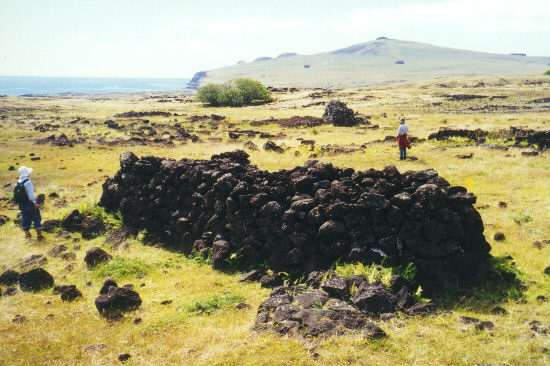
The tall hill in the distance is the Poike volcano on the eastern end of the island.
Features and Sites
After just a little field instruction we could recognize the archaeological features and as the survey progressed we became more and more adept at this identification. This page is a catalog of most likely individual features. Since individual features rarely occurred in isolation the discovery of one feature resulted in our searching the immediate area for associated features. This association meant that the survey team did not miss much, especially near the end of the two weeks. The measurement team also performed a mini-survey as they walked from one flagged site to another and in the immediate area of the flagged features to assure that everything was mapped.

The tall hill in the distance is the Poike volcano on the eastern end of the island. |
The most substantial feature of most sites is a hari moa, a "chicken house", so named because an early explorer saw a chicken come out of one. These are large and carefully constructed stone structures with a long narrow internal chamber with one or two small openings, just large enough for a chicken. Most that we found were broken into, perhaps by chicken thieves. Barry and I voiced our skepticism about the use of these structures. Chris admitted little detailed study has been done and with no better explanation to replace it, the traditional identification has stuck. The similar structure in the middle distance in the photo at left is not a hari moa but an ahu poepoe. These structures were used for exposing the bodies of dead. The bones might be left there or might be collected to be saved elsewhere. The ahu poepoe in the photo had some cranial fragments hidden in a small niche. As Clemente explained, the person is here, so her bones should remain here. |
| The manavai are generally the largest features and with the hari moa the easiest to find and identify. These circular constructions protected the plants within from the wind and helped to hold moisture. The rocks in the background of the picture at right constitute another feature, a lithic mulch garden. Although less substantial than the manavai, these rocks were deliberately distributed over large agricultural areas and served the same purpose for small plantings. |
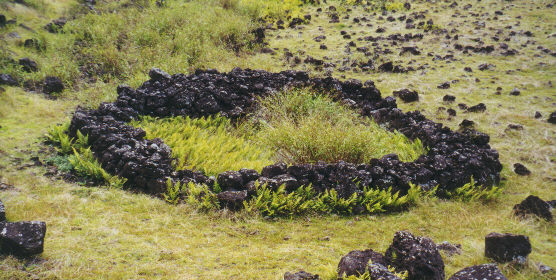 |
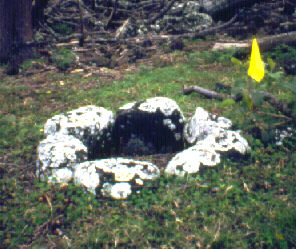 |
Umu pae, stone
lined earth ovens, are smaller but easy to spot, except in the tall
grass. The picture at left shows a nice example, but many were not fully
lined having only three or even a single stone.
Having flagged of the above large structures or come across an umu pae, the survey team looked for nearby companion features. A site almost always had one or more manavai, possibly a hari moa, an umu pai, and nearby, the hardest feature to find, the house. |
| The photo at right shows a nice
example of a house patio composed of surf rounded sea stones, poro,
transported from the shore. Few houses were as easy to spot as this
one. Some were hidden by the deep grass, most had far fewer stones,
perhaps only one, more a token than a patio.
Chris thinks the token poro indicate transient occupation of an area dedicated to agriculture rather than habitation. |
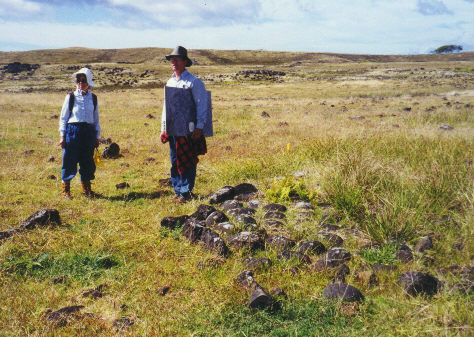 |
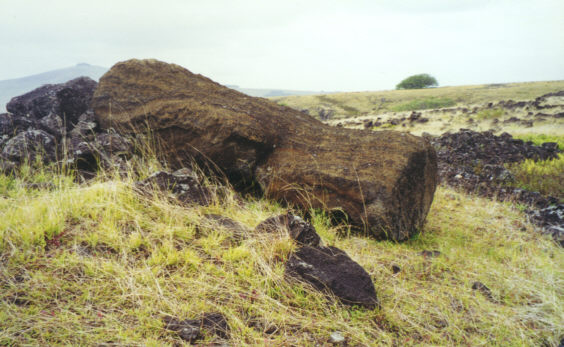 |
Mostly we found sites like those above, but this small inland ahu was in the survey area. The maoi was not large but intact and had been nicely carved. Inland ahu like this are important to Chris's habitation model because they indicate permanent settlement as opposed to transient occupation. |
This page and its contents © Copyright 1999 Michael & Karen Crisafulli. All rights reserved.